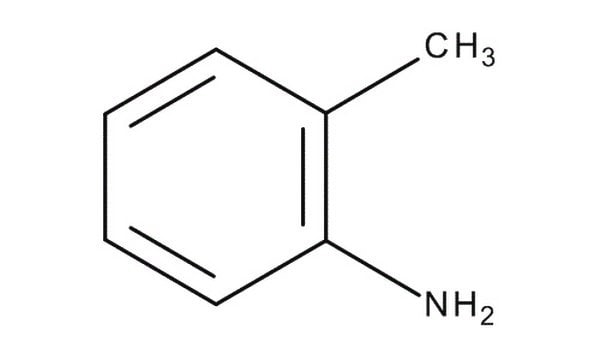89610
o-Toluidin
purum p.a., ≥99.5% (GC)
Synonym(e):
2-Aminotoluol, 2-Methyl-anilin
About This Item
Empfohlene Produkte
Dampfdichte
3.7 (vs air)
Qualitätsniveau
Dampfdruck
0.26 mmHg ( 25 °C)
Qualität
purum p.a.
Assay
≥99.5% (GC)
Form
liquid
Selbstzündungstemp.
899 °F
Verunreinigungen
≤0.1% water
≤0.5% m- and p-toluidine (GC)
Glührückstand
≤0.01% (as SO4)
Brechungsindex
n20/D 1.572 (lit.)
n20/D 1.572
bp
199-200 °C (lit.)
89-90 °C/11 mmHg (lit.)
mp (Schmelzpunkt)
−28 °C (lit.)
Löslichkeit
H2O: slightly soluble
Dichte
1.008 g/mL at 25 °C (lit.)
Kationenspuren
Ca: ≤5 mg/kg
Cd: ≤1 mg/kg
Co: ≤1 mg/kg
Cr: ≤1 mg/kg
Cu: ≤1 mg/kg
Fe: ≤1 mg/kg
K: ≤20 mg/kg
Mg: ≤1 mg/kg
Mn: ≤1 mg/kg
Na: ≤20 mg/kg
Ni: ≤1 mg/kg
Pb: ≤1 mg/kg
Zn: ≤1 mg/kg
SMILES String
Cc1ccccc1N
InChI
1S/C7H9N/c1-6-4-2-3-5-7(6)8/h2-5H,8H2,1H3
InChIKey
RNVCVTLRINQCPJ-UHFFFAOYSA-N
Suchen Sie nach ähnlichen Produkten? Aufrufen Leitfaden zum Produktvergleich
Allgemeine Beschreibung
Anwendung
Vorsicht
Signalwort
Danger
H-Sätze
Gefahreneinstufungen
Acute Tox. 3 Inhalation - Acute Tox. 3 Oral - Aquatic Acute 1 - Aquatic Chronic 2 - Carc. 1B - Eye Irrit. 2
Lagerklassenschlüssel
6.1A - Combustible acute toxic Cat. 1 and 2 / very toxic hazardous materials
WGK
WGK 3
Flammpunkt (°F)
185.0 °F - closed cup
Flammpunkt (°C)
85 °C - closed cup
Persönliche Schutzausrüstung
Eyeshields, Faceshields, Gloves, type ABEK (EN14387) respirator filter
Choose from one of the most recent versions:
Besitzen Sie dieses Produkt bereits?
In der Dokumentenbibliothek finden Sie die Dokumentation zu den Produkten, die Sie kürzlich erworben haben.
Kunden haben sich ebenfalls angesehen
Unser Team von Wissenschaftlern verfügt über Erfahrung in allen Forschungsbereichen einschließlich Life Science, Materialwissenschaften, chemischer Synthese, Chromatographie, Analytik und vielen mehr..
Setzen Sie sich mit dem technischen Dienst in Verbindung.














